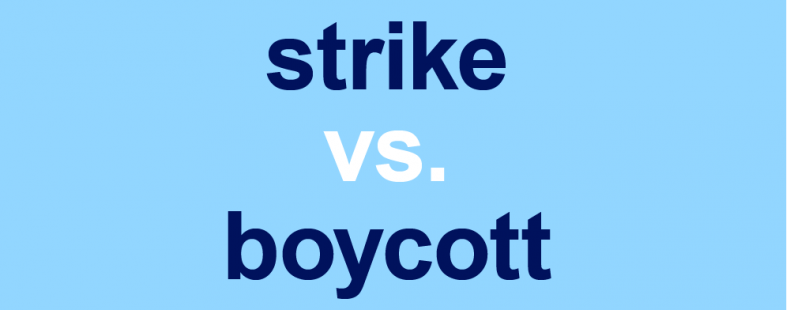Strike and boycott may be related terms, but they have different meanings. One is used to describe actions taken by a worker; the other refers to a an effort by consumer to take a stand against something.
But which is which? No need to protest—in this article, we’ll describe the differences between strike and boycott and provide some example sentences to show how they’re typically used.
What does strike mean?
As a verb, strike has a variety of definitions but typically means “to deal a blow or stroke to (a person or thing), as with the fist, a weapon, or a hammer; hit.” For example:
- With one strike to the head, the victim was out cold on the floor and wasn’t discovered until hours later.
- The babysitter was fired after a mom saw her strike a child on the nanny camera.
It can also mean to make an attack, hit against something, or ignite fire. Of course, it can also mean “to declare or engage in a suspension of (work) until an employer grants certain demands, such as pay increases.” When employees had safety concerns during the coronavirus pandemic, for example, some decided to strike.
Strike as a noun refers to an act or instance of striking and can be defined as “a concerted stopping of work or withdrawal of workers’ services, as to compel an employer to accede to workers’ demands or in protest against terms or conditions imposed by an employer.”
Although it can mean a temporary stoppage of something, strike has an entirely different meaning in baseball: “a pitch that is swung at and missed,” “a pitch that isn’t swung at even though it passed through the strike zone,” or “fouls when there are already two fouls against the batter.”
Strike’s first recorded use was before 1000, and it stems from the Middle English striken (“to stroke, beat, cross out”) via the Old English strīcan (“to stroke, make level”). Synonyms for strike include hit and knock.
What does boycott mean?
When used as a verb, boycott means “to abstain from buying or using” in an effort to take a stand or make a statement. It can also be defined as “to combine in abstaining from, or preventing dealings with, as a means of intimidation or coercion.”
As a noun, boycott refers to the act or practice of boycotting. For example: She organized a boycott of a popular beauty brand after finding out they tested products on animals.
Boycott originates from the name Charles C. Boycott (1832–97), who was an English estate manager in Ireland. In 1880, when he attempted to evict some of his tenants during times of hardship, he was subject to ostracism and other nonviolent coercive tactics from the townspeople. Synonyms for boycott include avoid, blacklist, cut off, exclude, refuse, and reject.
How to use each word
The key to remembering the difference between boycott and strike is to figure out who is taking action: the consumer or the employee? Workers strike against their employers while consumers opt against financially or physically supporting something as a way of peacefully protesting against it. Consumers boycott.
For example:
- After finding out that their counties required them to go back into classrooms during the coronavirus pandemic, many teachers across the country threatened to strike.
- After the students boycotted the bookstore, its owner agreed to remove the offensive ad from the display window.
- The manager hopes the employees don’t strike during the holidays, which happens to be the factory’s busiest month.
Another term to note is wildcat strike, which is a specific type of labor strike that has not been called or sanctioned by the officials of the union. Because the Milwaukee Bucks, and NBA players in general, are represented by a union and broke their contract to go on strike, they were participating in a wildcat strike.
- Strikes and boycotts usually fall within greater social movements or global calls to action. Read about other acts of protest that have shaped the landscape of US culture and politics.
- By the way, how masterful are you at dropping some scathing remarks? Would that make you a pro at protest or dissent?














